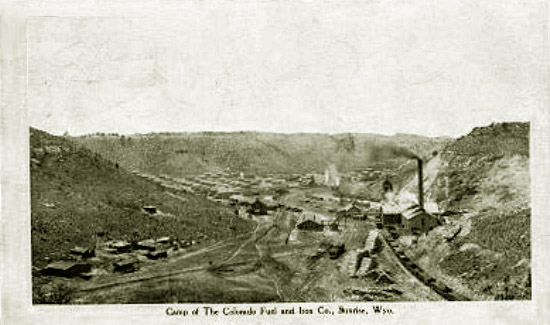
Sunrise, Wyoming, 1908
The Colorado Fuel & Iron Company was an amalgamation of various coal and
Iron Companies to form a vertically integrated steel company. The company controlled all phases of the
production of steel. It owned the iron ore mines, the coal companies, the foundry, the railroad that brought
the coal and ore to the foundry. It owned the miners, the town they lived in, and the company store, the
Colorado Supply Company, at which
the miners traded. In the words of the song:
You haul Sixteen Tons, whadaya get?
Another day older and deeper in debt.
Saint Peter don't you call me cause I can't go.
I owe my soul to the company store.
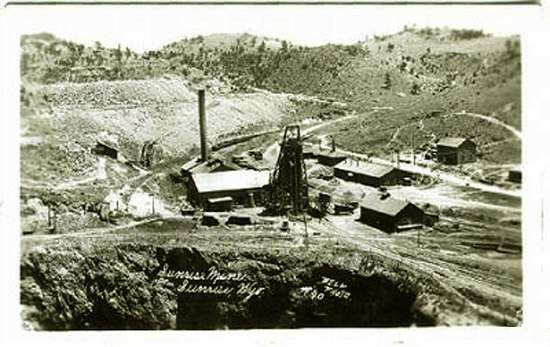
Sunrise Mine
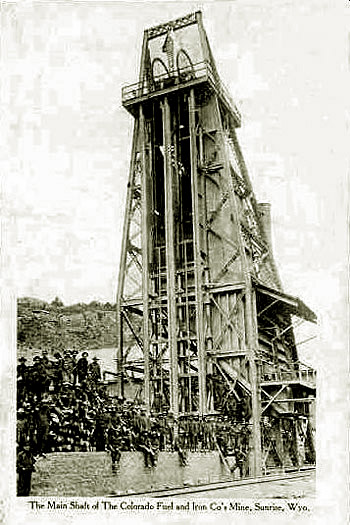 Sunrise Mine, 1907 Sunrise Mine, 1907
As observed by the editor of Mines and Mining, September 13, 1907:
Sunrise is a company town in the
fullest sense. Everthing, and may it
be said everybody, is owned by the
Colorado Fuel and Iron Company. No special
brand is necessary, for the fact impresses
itself indelibly on all who come
here. Visitors are not especially
welcomed, which a glance at the passenger
accommodations on the train that
meets the Colorado & Southern at
Hartville Junction forces itself on all
comers.
From Hartville Junction the spur to
Sunrise via Guernsey, a distance of about
fifteen miles, belongs and is operated by the
Colorado Fuel and Iron Company. It is a fine
piece of railroad engineering with its high grades and
frequent curves and one would not
mind paying two prices for transportation, as he must.
If only the accommodations were adequate, but, as has
been said, the company seems not to
care for that sort of traffic. Having constructed the
line for its own convience, no doubt it considers itself
an accommodator of the public by attaching a caboose
to its trains of ore cars, which caboose has poor seating
capacity for about eight people, through several times that
number travel over the route as a rule.
In contrast
to Union Pacific Coal Company camps where there were unions, CF & I control in its camps was
full and complete. In 1915 following the
Ludlow Massacre, the United States Commission on Industrial Relations issued a
report. The author of the report, George P. West, noted:
[T]he employees were forced not only to depend on the favor of the
Company for the opportunity to earn a living, but to live in such houses as the Company furnished, to buy
such food, clothing and supplies as the Company sold them, to accept for their children such instruction as
the companies wished to provide, and to conform even in their religious worship to
the Company's wishes. Report on the Colorado Strike, p 55.
Sunrise, although it was owned by CF & I, was not involved in the
strike. Its minister, the Reverend Daniel Spencer McCorkle (1880-1956) was almost
fired by the Company following the massacre. He had preached a sermon denouncing the massacre. The Reverend
McCorkle, however, repented of his ways when the Company informed him of "the facts
concerning that disturbance." Letter from CF & I president to Starr J. Murphy, Rockefeller's attorney, Oct. 31, 1914.
Thus, the president of CF & I wrote:
At the time of the Ludlow affair the minister was very outspoken in his criticism of the
coal companies, but seemed to regret his action when informed of the facts concerning that disturbance.
He has socialistic tendencies, however, and I have been informed that his wife is a Greek, yet they may both be perfectly
honest.
In actual fact, the Reverend McCorkle while at Missouri Valley College, organized a chapter of the
Intercollegiate Socialist Society and, according to the Montana Historical Society, remained a
lifelong member of the Socialist Party. In 1915, The Reverend McCorkle testified before
the Commission on Industrial Relations. In 1916, he was elected as moderator of the Cheyenne Presbytery. In 1917, due to his
wife's failing health, he returned to Montana where he had previously worked as a miner at Bearcreek. In addition to
Missouri Valley, The Reverend McCorkle had a master degree from Columbia and attended the Union
Theological Seminary.
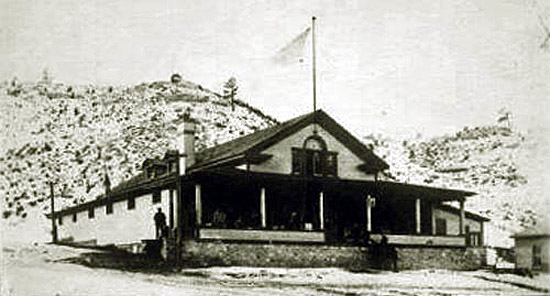
. Colorado Supply Company, the Company Store at Sunrise.
The first mines the "Glory HOle" and the "Chicago" were open pit mines using large steam shovels.
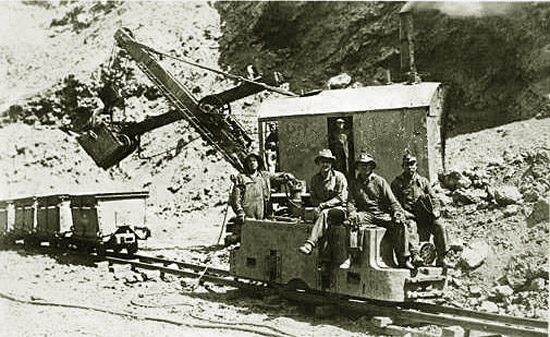
Steam Shovel, Sunrise.
By 1902, the Company also opened underground mines. Surface mining was discontinued in 1941. Sunrise as a town was founded in 1899.
At first, the town had the same miserably conditions as company towns in
the various coal camps. It had thirty-eight wooden four-room houses and a boarding house for single men.
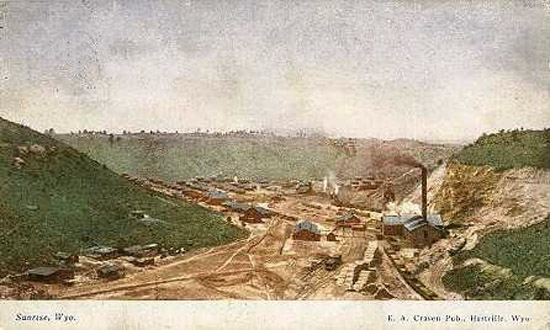
Sunrise, 1909.
Folowing almost universal condemnation of Rockefeller as a result of the Ludlow Massacre, Sunrise was made a model town. Houses were
improved.
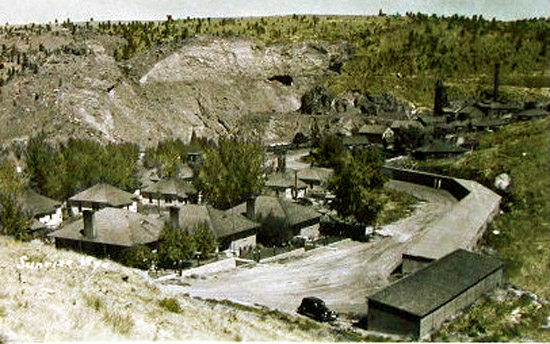
Housing, Sunrise, undated..
In 1917, a YMCA was constructed. The building had a bowling alley, and combination gymnasium, auditorium and moving picture theatre.
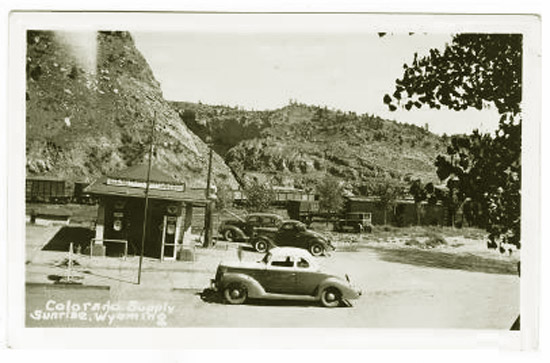
Colorado Supply Company gas station, railroad tracks beyond, Sunrise, approx. 1938.
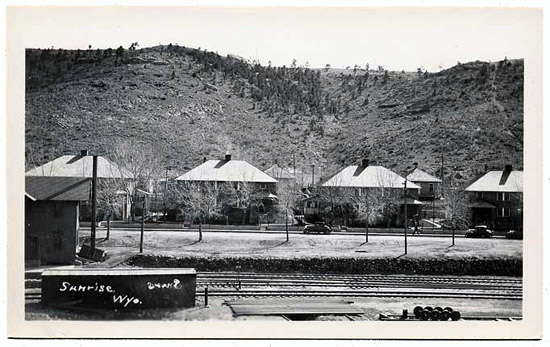
Railroad tracks, Sunrise, approx. 1938. The two-story houses were for company managers.
The Rockefeller
interests remained in control of CF & I until the 1944. The company began a program of diversification. All mining in Sunrise
was discontinued in 1980. In
1990, the company filed for bankruptcy. Sunrise, which at one time had a population of 1500 and was the third largest source of
iron ore west of the Mississippi, now is a ghost town. The wooden houses have all been removed. Surviing are some of the
brick structures constructed during the modernization. As of 2009, the town was for sale.
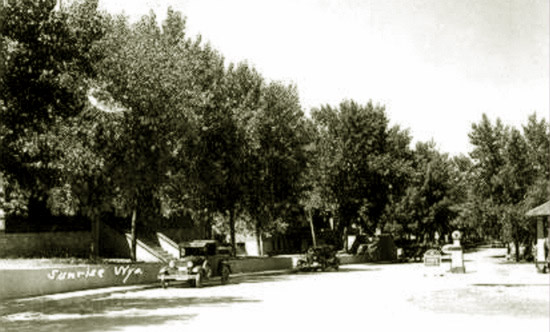
Sunrise, 1930's
Next Page: Hartville.
|